Trying to decide between the .223 Remington/5.56x45mm NATO and 6.5 Grendel cartridges? Here’s what you need to know about them.
I think most shooters and hunters, but especially those who like using Modern Sporting Rifles, probably agree that the .223 Remington/5.56x45mm NATO are effective cartridges in certain situations. At the same time, the shortcomings of those cartridges are also very apparent to many people. This has led to the development of cartridges like the 6.5 Grendel that are designed to improve upon the performance of the .223/5.56, but still function in an AR-platform.
The AR-platform is currently one of the most popular firearms in the United States and is widely used by gun owners. That’s not surprising because the AR-platform offers many inherent advantages for hunters and shooters. This has helped spur continued improvements to the AR-15 platform itself.
The popularity of the AR-15 has also resulted in the development of additional cartridges that offer distinct advantages over the .223/5.56 cartridge while also still functioning in an AR-15. The 6.5 Grendel is currently one of the most widely used of those cartridges. As good as it is though, the 6.5 Grendel is not perfect and there are some downsides to using it.
For that reason, this article is a detailed comparison of the 6.5 Grendel vs 5.56/223 where I discuss the strengths and weaknesses of each one so you can decide which cartridge is best for your particular hunting situation.
Before we get started, I have a few administrative notes for you.
First, though the .223 Remington and the 5.56x45mm NATO are technically different cartridges, the practical difference in performance between them is very small. Use extreme caution when attempting to interchange the .223 Remington and 5.56x45mm NATO cartridges though.
Read the article below for a more detailed discussion on the differences between the .223 Remington and 5.56x45mm NATO cartridges.
5.56x45mm NATO vs .223 Remington
Second, some of the links below are affiliate links. This means I will earn a small commission (at no extra cost to you) if you make a purchase. This helps support the blog and allows me to continue to create free content that’s useful to hunters like yourself. Thanks for your support.
Finally, I recorded an entire podcast episode on this exact subject. If you’d rather listen than read, click the appropriate link below to listen to this episode on your preferred podcasting service.
.223 Remington/5.56 NATO & 6.5 Grendel Podcast
Apple | Google | iHeart | Spotify | Stitcher
History Of The .223 Remington/5.56 NATO & 6.5 Grendel
The US Military began searching for a replacement for the relatively new M-14 rifle and 7.62x51mm cartridge during the 1950s. They eventually settled on the M-16 rifle and the high velocity 5.56x45mm cartridge, which was derived from the .222 Remington.
Remington saw the potential for a tremendous commercial opportunity and developed a civilian version of the new cartridge that was extremely similar, but not identical to the 5.56 NATO cartridge. Formally standardized with SAAMI as the .223 Remington in the early 1960s, the new cartridge was capable of firing a 55 grain bullet at muzzle velocities approaching 3,300 feet per second (1,330 foot pounds of energy).
The 5.56x45mm NATO cartridge had very similar ballistics and the original 5.56x45mm M193 ball load fired a .224″ 55 grain full metal jacket bullet at 3,250 feet per second (1,290 foot pounds of energy).
Unfortunately, the 5.56x45mm NATO cartridge and M-16 rifle got off to a very rough start in service with the U.S. Army and Marine Corps in Vietnam. Modifications to the rifle and ammunition solved most of the reliability problems that plagued the system during the war. Large numbers of people in the U.S. military still had serious concerns regarding the stopping power of the diminutive cartridge though, especially with the new M855 load adopted with the M-16A2 rifle.
Incorporating a new bullet design with a steel penetrator, the M855 load fired a 62 grain full metal jacket bullet at 3,025 feet per second (1,260 ft-lbs of energy). The M855 penetrates much better than the M193, but complaints about the terminal performance of the 5.56x45mm cartridge from Soldiers grew even loader after the new ball load saw use in combat in the 1990s and early 2000s.
Civilian hunters who adopted the AR-15 and .223 Remington cartridge during the last couple decades of the 20th Century shared many of those concerns. The rifle and cartridge worked extremely well for predator/varmint hunting and target shooting, but the .223 Remington also developed a reputation for unsatisfactory performance on bigger game like deer.
However, the AR-15 platform offered a number of advantages to shooters and eventually became very popular in the United States. With this in mind, gun designers with their finger on the pulse of the American hunting and shooting communities understood they were looking at a potentially massive opportunity.
Realizing that many people loved the AR-15 as well as the fact that the .223 Remington cartridge was not the best choice for hunting big game, designers set about developing a number of larger bore cartridges that were more powerful than the .223 Remington, but would still function in AR-15 rifles.
Among others, this list includes cartridges like the .300 Blackout, 6.8 Remington SPC (also known as the 6.8SPC), the .450 Bushmaster, the .458 SOCOM and the .50 Beowulf.
Bill Alexander developed the .50 Beowulf as a big bore alternative to the .223 Remington/5.56x45mm NATO in 2001. He also designed the 6.5 Grendel (sometimes misspelled 6.5 Grendal) as a medium bore option in this same market niche in 2002.
By modifying a 6.5mm PPC case (itself descended from the .220 Russian and the 7.62x39mm cartridges), Alexander was very successful in building an efficient, accurate, and sweet shooting cartridge that functioned very well in the AR platform.
Capable of firing a 120 grain bullet at 2,600 fps (~1,800 foot pounds of energy), the 6.5 Grendel cartridge is also significantly more powerful than the .223 Remington.
The 6.5 Grendel cartridge is also extremely versatile and works extremely well for long range shooting, tactical, law enforcement, varmint hunting, and big game hunting applications.
The cartridge did initially struggle to gain widespread acceptance in the shooting and hunting communities for a variety of reasons, one of which was the fact that Bill Alexander trademarked the name of cartridge. However, Alexander relinquished the trademark in 2011 when the cartridge gained SAAMI approval, thus allowing other companies to manufacture ammo, barrels, etc. bearing the name 6.5 Grendel.
Since then, the 6.5 Grendel has gained traction as an effective hunting round with more and more hunters who appreciate the improved performance it offers over the .223 Remington/5.56x45mm NATO and have adopted the cartridge accordingly.
223/5.56 vs 6.5 Grendel: Cartridge Sizes
As you can see in the photo below, there are some big differences between the .223 Remington and 6.5 Grendel cartridges.
First, the cartridges use different diameter bullets: 224″ for the .223 Remington/5.56x45mm NATO and .264″ for the 6.5 Grendel.
Most 6.5 Grendel ammo typically has bullet weights in the 90-130 grain range, with 100 grain, 110 grain, 120 grain, and 123 grain bullets being the most popular. On the other hand, the majority of .223/5.56 factory loads shoot bullets in the 35-77 grain range. Of these, 55 grain and 62 grain bullet weights are by far the most common.
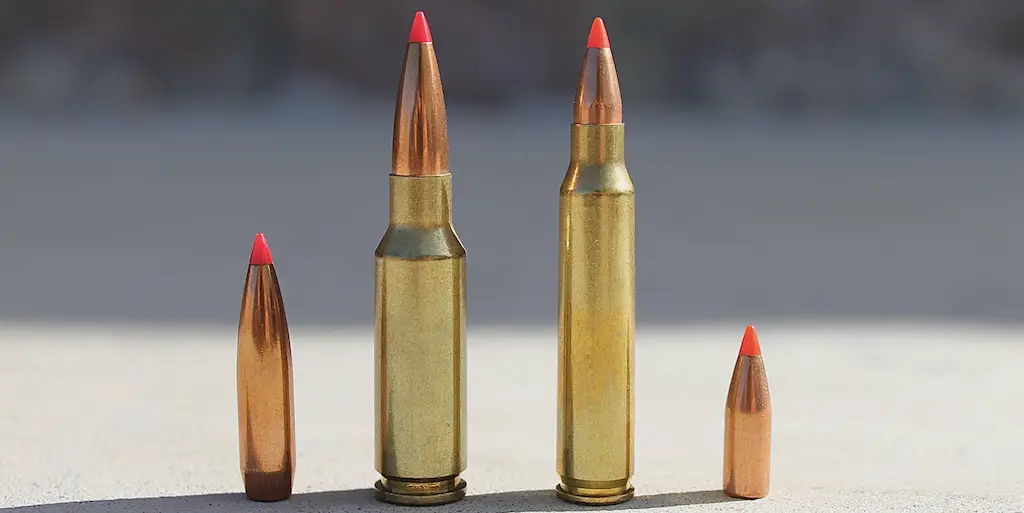
Both cartridges are designed for use in an AR-15, which can only accommodate cartridges up to 2.26″ long. So, the .223 and 6.5 Grendel each have the same overall length of 2.26″, which is the maximum size cartridge that will fit in an AR-15.
However, even though the .223 Remington uses has a longer case, the 6.5 Grendel has a slightly larger case capacity that can hold more powder since it’s larger in diameter.
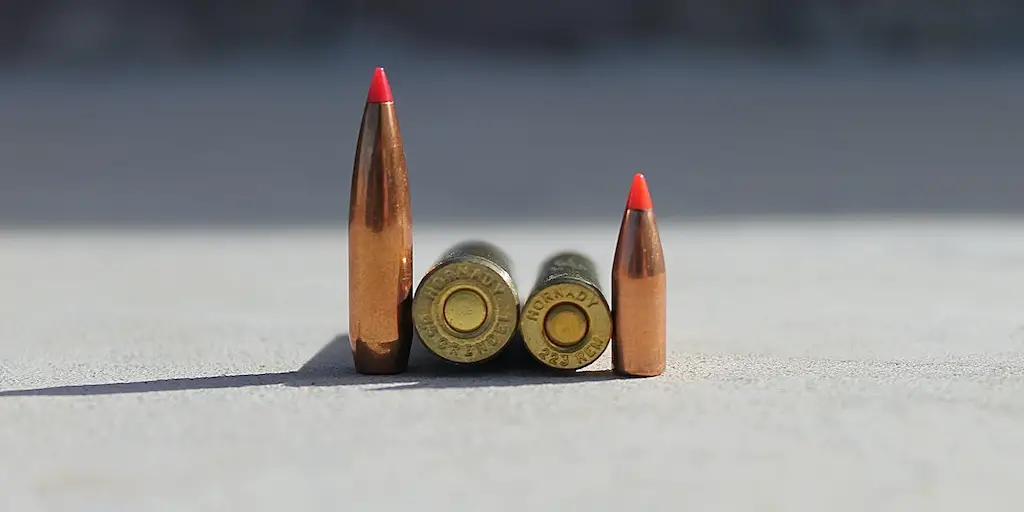
On the other hand, the .223 Remington has a slightly higher maximum SAAMI authorized pressure than the 6.5 Grendel (55,000psi vs 52,000psi).
Note: while the case capacity figures listed below do give a good indication of the differences between the two cartridges, exact case capacities vary slightly according to the brand of brass used.
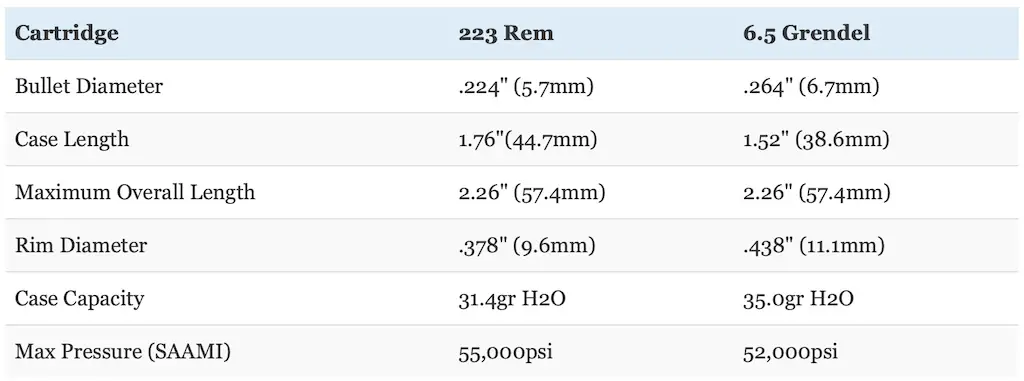
6.5 Grendel vs 223/5.56 Ballistics
Those differences in the external dimensions of the 6.5 Grendel, .223 Remington, and 5.56x45mm NATO translate into some interesting differences in their ballistic performance.
This is illustrated in the table below comparing Federal and Nosler factory ammunition. The 6.5 Grendel loads use a 120gr Soft Point (.340 BC) and 120gr Nosler Ballistic Tip (.458 BC). Federal produced both of the 5.56x45mm factory loads to roughly mirror the performance of the 55gr M193 ball (.246 BC) and 62gr M855 ball (.349 BC) loads used by the military. The .223 Remington factory loads use a 62gr Soft Point (.310 BC) and a 55gr Nosler Ballistic Tip (.267 BC).
The Federal loads use a 16″ barrel and the Nosler loads use a 24″ barrel. All six loads used a 200 yard zero.
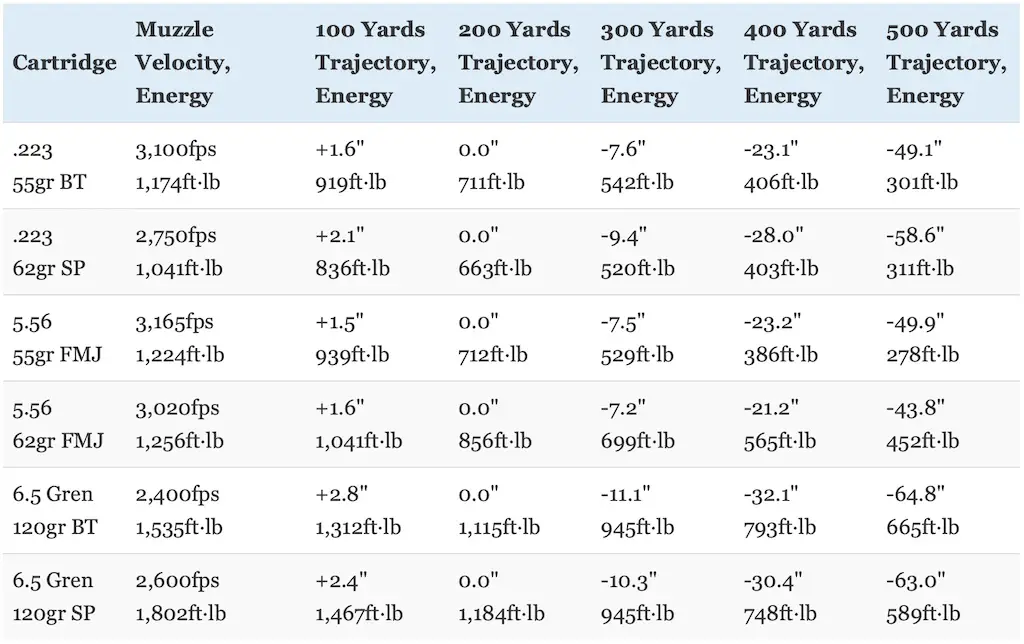
As you can see, the 6.5 Grendel has a significant edge in terms of kinetic energy at all ranges. With the exception of the 62gr FMJ bullet used by the M855 5.56mm load, both 6.5 Grendel loads shoot bullets with a higher ballistic coefficient. The 6.5 Grendel also uses bullets that are about twice as heavy.
So, the 6.5 Grendel starts off with significantly more energy at the muzzle (22-73% more depending on the exact load) and this advantage in retained energy grows as the range increases (30-139% more at 500 yards).
On the other hand, the .223 and 5.56 loads have a flatter trajectory (less bullet drop) at all ranges.
The chart below compares how much a 10 mile per hour crosswind impacts those same .223 Remington, 5.56x45mm NATO, and 6.5 Grendel loads out to 500 yards.
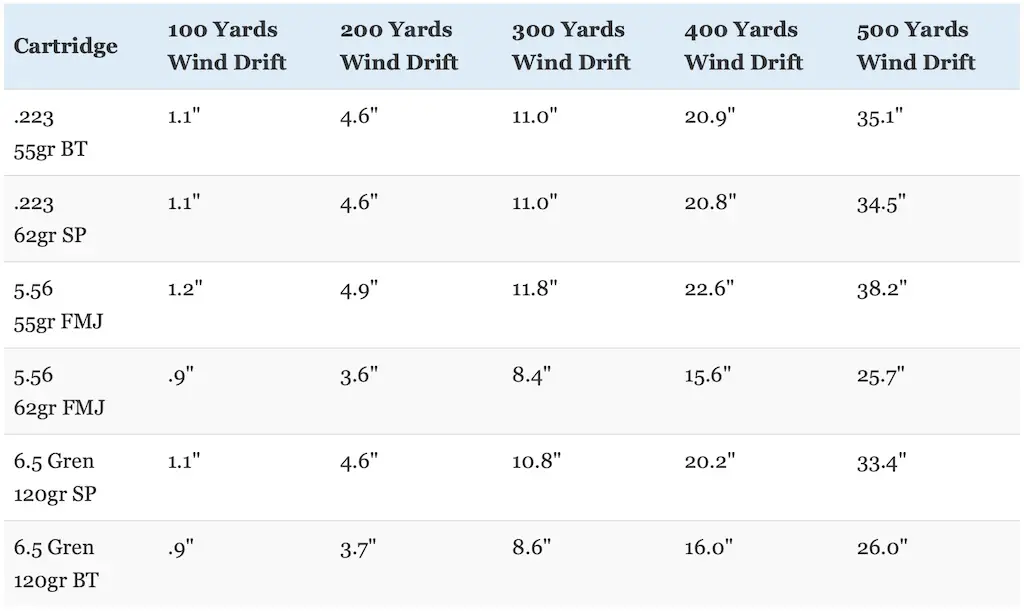
With the exception of the 62gr M855 load, the 6.5 Grendel outperforms the .223 Remington and 5.56 NATO in terms of wind drift at all ranges. The difference is relatively small with the Federal 6.5 Grendel load, but the 6.5 Grendel has a pretty significant advantage with the Nosler load.
The table below compares the recoil produced by handloads that are very similar to the Nosler loads compared above for the .223 Remington and 6.5 Grendel when fired from identical rifles.
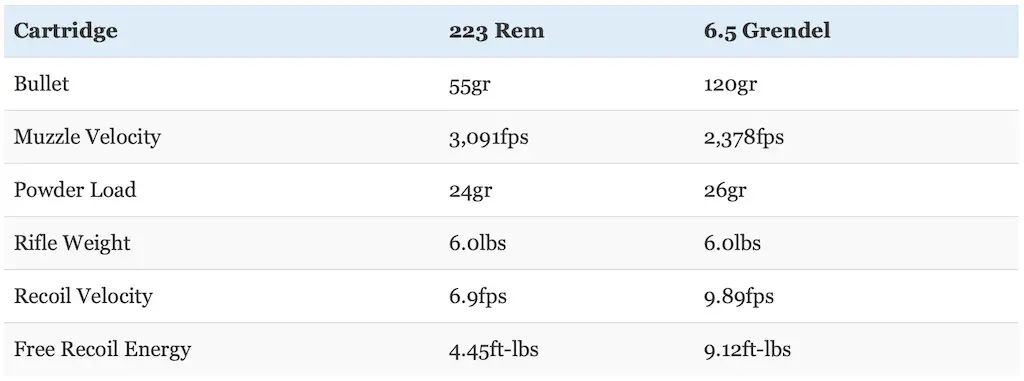
Felt recoil will vary from shooter to shooter and rifle to rifle, but free recoil energy is still a useful way to compare cartridges.
As you can see, the .223 Remington has significantly less recoil than the 6.5 Grendel. Depending on the exact load, the 6.5 Grendel has approximately twice as much recoil! That’s really saying something too because the 6.5 Grendel is a relatively mild recoiling cartridge.
All things considered, most hunters should be able to handle recoil from the 6.5 Grendel without too much trouble. The .223 Remington just has an extremely mild (almost non-existent) recoil. So, the .223/5.56 has a big advantage in this respect, especially for smaller or recoil shy hunters.
Don’t underestimate the impact that recoil has on the ability of a person to shoot accurately either. Some people do handle recoil better than others, but all other things being equal, they will absolutely shoot more accurately with a milder recoiling cartridge.
What about 6.5 Grendel vs 5.56/223 accuracy?
The .223 Remington in particular has seen extensive use in the hands of competition shooters and has an outstanding reputation in that area. However, the 6.5 Grendel also excels in that area as well and, if we’re being honest, both cartridges are absolutely capable of tack driving accuracy (sub-MOA, sometimes much better) in the right hands.
Though the exceptionally mild recoil of the .223 Rem gives that cartridge an advantage at short range (150 yards or less), the 6.5 Grendel has a longer effective range and a big advantage at ranges past 200 yards because those heavier and more aerodynamic bullets retain more energy and are less susceptible to wind drift.
So where do we stand with each cartridge?
6.5 Grendel vs 5.56
The 6.5 Grendel fires larger diameter, heavier, and more aerodynamic bullets than the 5.56 NATO. The 6.5 Grendel has significantly more retained kinetic energy than the 5.56/223 at typical hunting ranges. However, the 5.56 NATO and .223 Remington have higher velocities, much less recoil, and a flatter trajectory.
When comparing these cartridges, it’s important to remember that the 6.5 Grendel was designed to offer better performance out of an AR-15 ballistically than the .223 Remington. As you can see, Bill Alexander was very successful in accomplishing that goal.
All told, the 6.5 Grendel is a moderately powerful, mild recoiling, and relatively flat shooting cartridge that’s also pretty resistant to wind drift. This is especially remarkable considering that the cartridge packs that level of performance into a very small package that can still fit in the relatively tight constraints of the AR-15 platform.
This 6.5 Grendel is a very good all around cartridge for those who want to use an AR-15 for deer hunting at short to moderate range. In addition to hunting, the 6.5 Grendel is also a really nice choice for self defense/personal protection for people who like the AR-15 platform. The cartridge also has very good barrel life.
The 6.5mm bore diameter is also in something of a sweet spot where it’s easier to manufacture very high BC bullets that’s aren’t especially heavy (like the Hornady ELD Match). Those aerodynamic projectiles don’t slow down as fast and are more resistent to wind drift.
At the same time, the 6.5 Grendel also has big edge over the .223 Remington and 5.56x45mm NATO in bullet sectional density.
Sectional density (SD) is a measure of the ratio of the diameter of a projectile to its mass. All other things equal, a heavier projectile of a given caliber will be longer and therefore have a higher sectional density and consequently penetrate deeper than projectiles with a lower mass and sectional density.
As an example, 120 grain, 123 grain, and 129 grain .264″ bullets have sectional densities of .246, .252 and .264 respectively. This compares favorably to 55 grain, 62 grain, and 77 grain .224″ bullets which have sectional densities of .157, .177, and .219 respectively.
Even so, the 6.5 Grendel doesn’t “punch above its weight” to nearly the degree of cartridges like the 6.5 Swede, 7mm Mauser, or 9.3x62mm Mauser though.
All things considered, the 6.5 Grendel is simply a significantly more powerful cartridge. It’s not a heavy hitter even on the level of cartridges like the .308 Winchester, but it’s still in a completely different league from the .223 Remington and 5.56 NATO.
In addition to the advantages in bullet sectional density and kinetic energy that we’ve already discussed, the 6.5 Grendel uses larger diameter bullets. Consequently, it has about 39% more frontal surface area (also known as cross sectional area) than the 223/5.56 (.0547 vs .0394 square inches).
All other things being equal, a bigger bullet will make a bigger hole, cause more tissue damage, and result in more blood loss.
The 6.5 Grendel is also designed to use significantly heavier bullets, which along with the fact that it generally uses more aerodynamic bullets, helps the 6.5 Grendel carry more energy downrange. Combined with the larger diameter and frontal surface area of the bullets used by the cartridge, hunters have a tiny bit more room for error in shot placement when compared to the .223 Remington and 5.56x45mm NATO.
Those characteristics are especially helpful when hunting larger game.
Make no mistake: .223 Remington is an outstanding varmint hunting cartridge. Advances in bullet technology in recent years have also made those cartridges much more effective on deer sized game than they used to be.
Lots of people successfully harvest deer with the .223 Remington each year and the mild recoil of the cartridge makes it a nice option for small framed or recoil shy hunters.
However, it’s also just a plain fact that the 6.5 Grendel is better for deer hunting (if the hunter can place his or her shots appropriately).
In my humble opinion, the 6.5 Grendel is not a good choice for hunting any game bigger than deer though. Even though it’s significantly more powerful than the .223 Remington, I don’t recommend using the 6.5 Grendel for hunting elk, moose, black bear, or other game like them.
5.56/223 vs 6.5 Grendel Ammo
The .223 Remington is currently one of the most popular cartridges in the United States. When .223 Remington and 5.56 NATO sales numbers are combined, they’re far and away the most popular centerfire rifle cartridges in terms of the total number of rounds sold. Even though the 6.5 Grendel is a reasonably popular cartridge, it cannot compare to the .223 in terms of popularity.
Even so, there’s a decent selection of factory ammo choices for these cartridges.
Just about every ammunition manufacturer produces several different loads of .223 Remington and 5.56 NATO ammunition.
This ammo ranges from match grade and surplus FMJ ammo best suited for work at the range on one end of the spectrum, to hollow point, soft point, and ballistic tip ammo designed for hunting and personal protection on the other end.
Note that FMJ ammo is generally NOT legal for hunting in most states. So, while that military surplus 5.56x45mm ammo is good for use at the range, I don’t recommend taking it afield in search of game.
Most .223 and 5.56 NATO ammunition is designed for target shooting or plinking, but companies like Barnes, Federal Premium, Hornady, Nosler, Remington, and Winchester all produce ammunition in those chamberings suitable for hunting.
Most of this is varmint hunting ammo, like Hornady’s Varmint Express and Superformance Varmint lines, Nosler’s Varmageddon line, and Winchester’s Varmint X line. However, there are also a handful of .223 Remington ammo options specifically designed and marketed for big game hunting.
For instance, there are both .223 and 5.56 loads in the Barnes VOR-TX line, Federal offers .223 Remington ammo in their Fusion line, and Winchester produces .223 Remington ammo in their Deer Season XP, Power Max Bonded, and Super X lines.
At the same time, 6.5 Grendel ammo is available from Hornady with their American Gunner, Black, and Custom lines, from Federal with their Fusion MSR and American Eagle lines, and Nosler with their Ballistic Tip and Trophy Grade Long Range lines.
In particular, Hornady’s factory load using a 123gr SST bullet as part of their Custom line is a very popular and effective deer hunting option with the 6.5 Grendel.
Alexander Arms still produces 6.5 Grendel ammo and Wolf also offers a pretty good low priced full metal jacket (FMJ) option for the cartridge.
During normal times, it’s usually very easy to find .223 Remington and 5.56x45mm ammo and almost any gun or sporting goods store will have a wide variety of .223 and 5.56 ammo in stock. However, while I wouldn’t say that it’s rare, not every sporting goods store keeps 6.5 Grendel ammo in stock.
Availability of ammunition is usually pretty good online and the bigger retailers typically have a good selection of quality factory ammo for both cartridges in stock. .223 Remington and 5.56x45mm NATO ammunition is generally significantly cheaper than 6.5 Grendel ammunition as well.
BUY SOME QUALITY .223 REMINGTON AMMO HERE
BUY SOME GREAT 5.56 NATO AMMO HERE
BUY SOME EXCELLENT 6.5 GRENDEL AMMO HERE
If you’d like to learn more about some of the various hunting ammunition choices for the 223 Remington and 6.5 Grendel, read these articles:
Best 223 Ammo For Hunting Deer, Hogs, And Other Big Game
Best 6.5 Grendel Ammo For Hunting Deer And Other Big Game
Handloading components for these cartridges are widely available for those want to reload these cartridges, but the .223 Remington and 5.56 NATO are once again much more common than components for the 6.5 Grendel.
The .223 Remington and 5.56 NATO use the same .224″ bullet size as the 219 Zipper, 222 Remington, 22 Hornet, 225 Winchester, 224 Valkyrie, 224 Weatherby Magnum, .22-250 Remington, and .220 Swift.
The 6.5 Grendel shoots the same .264″ bullet size that’s also used by the 6.5 Creedmoor (often misspelled 6.5 Creedmore), .260 Remington, 6.5×55 Swede, and 6.5 PRC (among others).
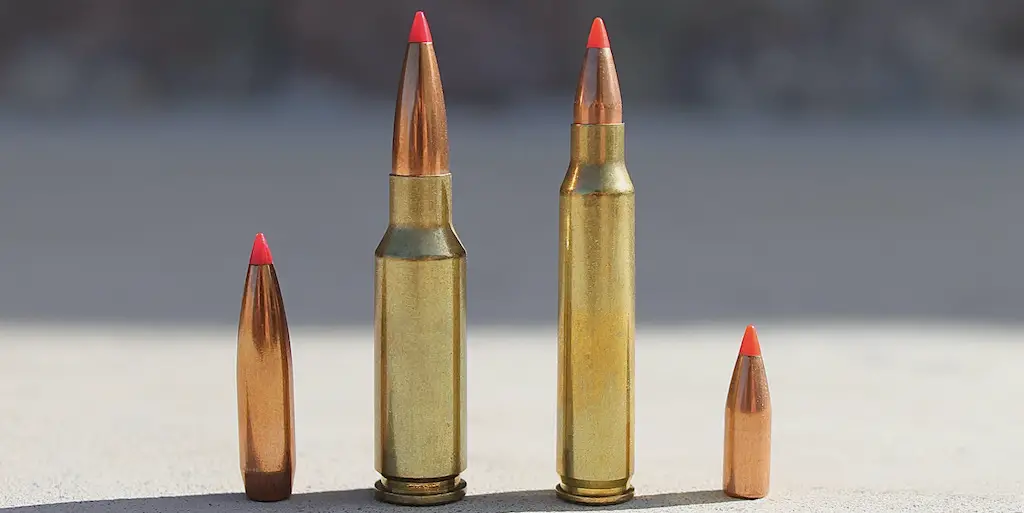
5.56/223 vs 6.5 Grendel Rifles
Once again, the .223 Remington and 5.56x45mm NATO are much more common than the 6.5 Grendel. However, there’s a good selection of rifles chambered in all three cartridges.
Remember: a rifle with a 5.56 NATO chamber can usually safely and accurately fire .223 Remington ammunition, but the reverse is not always true. So, many (but not all) gun manufacturers chamber their rifles in 5.56x45mm NATO so their customers have more flexibility with ammo.
The .223 tends to be more common in bolt action rifles like the Browning X-Bolt, Ruger American, Remington 700, and Winchester XPR. The 5.56 NATO is an extremely popular chambering for AR-15 style rifles like those made by Bushmaster, CMMG, Noveske, Smith & Wesson, Sig Sauer, and Wilson Combat. It’s also available in other semi-automatic sporting rifles like the Ruger Mini-14.
That’s not a hard and fast rule though and it’s not unusual to find bolt action 5.56 rifles.
For instance, the lightweight CZ 527 and the Ruger American Ranch bolt-action rifles are both available in 5.56 NATO.
Alexander Arms manufactured the first rifles in 6.5 Grendel and continues to do so. Since then, Wilson Combat and a couple of other companies like Radical Firearms and Brenton USA have started producing modern sporting rifles chambered in the cartridge. It’s also possible to purchase a 6.5 Grendel upper receiver and convert an existing AR-15 to shoot the Grendel.
The 6.5 Grendel can use regular M16 rifle/M4 carbine magazines with a slight decrease in magazine capacity (and sometimes in reliability). A typical 30 round magazine will hold 26 6.5 Grendel rounds.
The Ruger American Predator and Ruger American Ranch bolt action rifles are also both available in 6.5 Grendel. The same goes for the Howa Mini and CZ 527 for hunters who prefer to use a bolt gun.
BUY A NICE 223 REMINGTON RIFLE HERE
BUY A GREAT 5.56 NATO RIFLE HERE
BUY A DEPENDABLE 6.5 GRENDEL RIFLE HERE
6.5 Grendel vs 5.56: Which Is Right For You?
Do you primarily hunt medium sized game like whitetail deer or feral hogs at ranges within 200 yards? All of these cartridges will get the job done if you do your part. However, the 6.5 Grendel is significantly more powerful and I strongly recommend using it for hunting deer instead of the .223 Remington or 5.56 NATO.
Are you looking for a cartridge to hunt predators and small game animals with? The 6.5 Grendel will work in this role and lots of people use it for predator hunting. However, I think the .223 Remington is the best choice here because it has a flatter trajectory, ammunition is cheaper, and there are many types of .223 ammo specifically designed for predator and varmint hunting.
Do you want a hunting cartridge that’s well suited for caribou, moose, elk, eland, kudu, or red stag hunting? I consider all of these cartridges to be on the light side and strongly recommend against using the .223 Remington, 5.56x45mm NATO, and 6.5 Grendel for elk hunting (as well as on game bigger than deer in general). If you had to choose one, I’d definitely go with the 6.5 Grendel because it shoots heavier and larger diameter bullets that carry much more kinetic energy downrange.
Do you want a cartridge suitable for self or home defense? All three cartridges will certainly work in this regard, but the 6.5 Grendel likely has the edge here as well. Even though it has more recoil than the .223 Remington and 5.56 NATO, the 6.5 Grendel still has a very mild recoil that facilitates follow-up shots. It also shoots a larger and heavier bullet with more energy.
Are you looking for the perfect cartridge to use in a short barreled rifle (SBR)? All of these cartridge will lose a certain amount of velocity with shorter barrel lengths, but I lean towards the 6.5 Grendel here. It performs closer to its full potential with a shorter 16-18 inch barrel and loses less velocity than the .223 Remington and 5.56 NATO.
Are you sensitive to recoil and in need of a serious low recoil cartridge? The .223 Remington and 5.56 NATO have significantly less recoil than the 6.5 Grendel, especially in a lighter rifle.
Do you want the round that is best suited for target shooting out past 400 yards or so in a precision rifle? All work and have excellent reputations for precision shooting, but I’d lean towards the 6.5 Grendel for work at longer ranges since there are much better prospects for high BC, match grade 6.5mm bullets.
As I’ve stated several times in this article, the .223 Remington, 5.56x45mm NATO, and 6.5 Grendel are all solid rifle cartridges. However, since they were designed with very different goals in mind, the differences between them (6.5 Grendel vs 5.56) is pretty big in many respects. Carefully evaluate your needs as a hunter based upon the circumstances you foresee using the cartridge in, get a good hunting rifle chambered in the cartridge you select, learn to shoot it well, use quality bullets, and it should serve you well afield.
NEXT: BEST 6.5 CREEDMOOR AMMO FOR HUNTING ELK, DEER, & OTHER BIG GAME
NEXT: 22-250 vs 223 REMINGTON REVIEW & COMPARISON
Enjoy this article comparing the 6.5 Grendel and 5.56/223 cartridges? Please share it with your friends on Facebook and Twitter.
The Lyman 50th Edition (p139-143, 181-182) and Hornady 10th Edition (p160-178, 301-304) reloading manuals were used as references for the history of the cartridges. I obtained the data used to compare the trajectory of the cartridges from Federal (here and here), Nosler (here and here), and Winchester. Data used to calculate recoil was obtained from Nosler (here and here). Case capacities were obtained from Chucks Hawks (here and here). Maximum pressure obtained from SAAMI (p23 & 26). I used ShootersCalculator.com to compare trajectory and recoil for the cartridges.
Make sure you follow The Big Game Hunting Blog on Facebook, Instagram, Twitter, and YouTube.
John McAdams is a proficient blogger, experienced shooter, and long time hunter who has pursued big game in 8 different countries on 3 separate continents. John graduated from the United States Military Academy at West Point and is a veteran of combat tours with the US Army in Iraq & Afghanistan. In addition to founding and writing for The Big Game Hunting Blog, John has written for outdoor publications like Bear Hunting Magazine, The Texas State Rifle Association newsletter, Texas Wildlife Magazine, & Wide Open Spaces. Learn more about John here, read some of John’s most popular articles, and be sure to subscribe to his show: the Big Game Hunting Podcast.


So out to 500 yards there’s not much to sway my opinion that Grendel is superior. Couple hundred foot pounds difference.